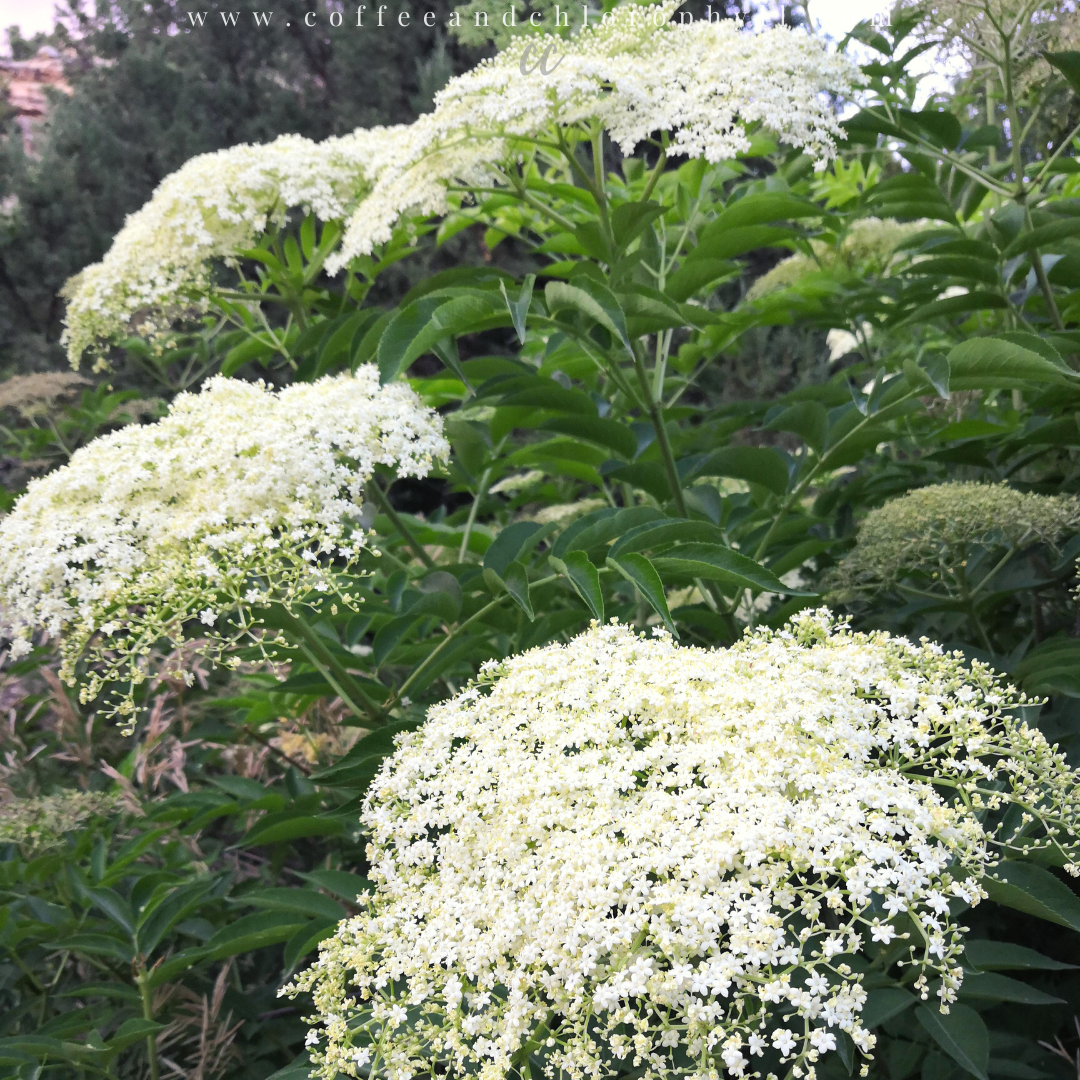One of the first planting projects we tackled this spring was planting a hedge of bareroot elderberries. We also did this at our last house, but we moved, unfortunately, before it reached it’s stride. A nice, thick elderberry hedgerow takes a few years to fully mature. Once mature, elderberry hedges provide dense cover, perfect for wind screening or privacy screening, and lots of elderberries. The berries are loved by the birds and perfect for making an immune boosting tonic. They are also beautiful. They have lovely, fragrant flower heads that can be used for cordials or wines, or left for the pollinators to enjoy!
Types of Elderberries
There are a few types of elderberries available. Here is a quick rundown of the most common types available for planting in your garden:
American Elderberry—(Sambucus canadensis OR Sambucus nigra ssp. candensis)
Native to Eastern North America and beyond; Produces nearly black berries (as photographed on this page)
Very similar to European Elderberry—in fact, this is a specific subspecies of Sambucus nigra; it stays smaller and more shrub-like than standard European strains, and some research indicates that it has higher antioxidant levels, as well
Cultivars available for purchase include ‘York’, ‘Adams’, ‘Johns’, ‘Nova’, ‘Wyldewood’, ‘Bob Gordon’, and ‘Ranch’
European Elderberry—(Sambucus nigra)
Widespread; Native to Europe and beyond
Also referred to as black elderberry, with berries that are nearly black being grown upon very large (up to 20 foot tall & wide) shrubs
Cultivars available for purchase include ‘Korsor’, ‘Allesso’, ‘Marge’, and ‘Samdal’; many of the ornamental elderberries also appear to be Sambucus nigras, including Proven Winners’ ‘Black Beauty’ with dark foliage and Proven Winners’ ‘Instant Karma’ with variegated foliage
Red Elderberry—(Sambucus racemosa)
Grows best in cool-moist regions
Native to North America, Europe, and Asia
Produces bitter red berries
Flower heads are more conical in shape, as opposed to being flat umbels (like black elderberries)
Cultivars available for purchase include ‘Sutherland Gold’ and Proven Winners’ ‘Lemony Lace’
Blue (or Mexican) Elderberry—(Sambucus caerulea)
Native to western North America
Multi-stemmed shrub can get 30 feet tall and wide, and produces powder-coated bluish black elderberries
I’m not sure there are any improved cultivars of Blue Elderberry available. In fact, I don’t know if I have even come across more than one or two vendors selling Sambucus caerulea. Period. Please comment below if you know of any.
There’s magic in these humble umbels of elderberry flowers!
What We Planted
The cultivars of elderberry that we settled on planting are both American Elderberries. We planted Sambucus canadensis ‘Adams’ and Sambucus canadensis ‘York’. We planted these two cultivars, as cross-pollination leads to vastly better berry yields. We also chose to plant these varieties as they are both vigorous cultivars of our native elderberries. I am not opposed to non-native plants, but I try to plant natives whenever I can, because they are better suited to the conditions in our area, and better for the insects and, in turn, the birds that eat said insects. And you know me—I’m all about the birds! We plan on growing this elderberry hedge into a windscreen, so we densely planted them in along a fence, with each plant being only a few feet apart.
Cultivating American Elderberries
With the exception of a few ornamental Black Lace Elderberries, the only experience I have is with growing American Elderberries or Sambucus canadensis, so I can only speak to their culture in this section.
Starting Elderberries—You can grow American Elderberries from bare roots or nursery plants. I prefer bare roots and find them to be more cost effective and actually more mature plants than the plants started at nurseries. I have successfully ordered and started bare roots from both Stark Brothers and Burpee. If you are looking for a more ornamental elderberry, with variegated foliage or dark foliage, you will probably have to purchase an already started plant.
Something to keep in mind:
I see many people on social media saying stuff like “I want an elderberry bush!” or “I would love to grow an elderberry plant in my veggie garden.” I appreciate growing elderberries, too, but please realize that elderberries grow into very large, multi-stemmed, suckering shrubs. In other words, they won’t remain a tidy little bush in the corner of your 200 square foot garden plot. If you plant them in your raised bed, they are vigorous enough to fill the entire thing. Over time, they have been known to form a dense thicket. And also, because they produce better with cross-pollination, you are best off planting two. Keep this in mind, and only plant elderberries if you have the space to accommodate them.
Planting Bare Roots—When planting bare roots, hydrate your roots in a bucket of water while you are getting your site prepped for planting. I soak mine no longer than a couple hours. Prepare the site you will be planting them by removing any grass, weeds, or other plants that might compete for energy and resources, and then dig a hole, at least twice as wide as the bare roots. I amend the hole with some compost and a good handful of Espoma HollyTone fertilizer. HollyTone works really well for shrubs, berries, and plants that prefer a slightly more acidic situation. When you place your bare roots in the hole, be sure to separate the roots and spread them out a bit. Backfill the hole around the roots and tamp the soil down. Water them in thoroughly, to ensure no air pockets remain around the roots, and then mulch.
Plant in Full Sun to Part Sun—While elderberries will tolerate some shade, they will grow faster in sun. If you are growing one of the ornamental elderberries with black foliage, like Black Lace or Black Beauty Elderberry, they will hold their black foliage better if you plant them in a Part Shade spot. I grew these in full sun at our last house and the foliage faded to more of a green with dark leaf margins.
Water Regularly—Elderberries aren’t real fussy about soil, but they do like plenty of water. In fact, I had some really rocky dirt where I planted them at the last house. As long as I kept that lousy patch they were planted in well-watered, they were happy!
Pruning will Help Them Thrive—Do not prune until after the 2nd growing season has finished—then remove old, weak, or 3 year old canes. The best time to prune is in early spring, before the plants break dormancy. This is important. My in-laws have a dwindling elderberry hedge around their house. It has been in place for over 25 years—thriving for many of them. But they didn’t realize that elderberries needed pruning to perform their best. Pruning encourages new growth and allows space and energy for more fruitful canes.
Use Physical Barriers to Provide Protection from Critters
Protect your elderberries from deer, at least until the plants are a couple years old and established. Despite being widely advertised as “deer resistant", my deer like to nibble the tender new growth whenever possible. Therefore, to give elderberries the best start, I cage or fence my plants until they are established.
If you are growing elderberry as a food crop and want to get berries, you will need to protect the developing fruit from the birds, using netting for the whole plant or by bagging the clusters of berries. Birds love the fruit and will eat them all on a smaller, less established plant if you let them.
Destined to be made into winter’s medicine.
Using Elderberries
Because I am only familiar with American Elderberries, I can only speak as to their preparation here.
I haven’t even fully explored the realm of possibilities when it comes to using the fruit, but one thing I have learned, is that the fruit freezes well. I allow the birds to get most of the fruit, but I do like to freeze some berries in freezer bags to keep on hand. I also find it easiest to get the berries off the stems if I first freeze the clusters on a cookie sheet. Then, once they are frozen,the berries seem to release from the stems much easier. You can transfer the frozen clusters of berries to a brown paper bag, and shake like crazy. This will free many berries, but you will still likely have to sit and pick some from the stems.
Do not eat the stems, leaves, bark, or unripe berries of Elders—they are all toxic.
Some folks still are in a bit of a quandary over whether or not the ripe, raw, uncooked elderberries are also toxic. HERE is an article addressing this. As I pick elderberries, I have been known to toss back a few ripe, uncooked berries, and have had no ill effects. Only do what you feel comfortable doing, however, and if you have any doubts whatsoever about eating the berries uncooked—just don’t do it! Err on the side of caution and cook them first!
Elderberries are excellent for making an immune-boosting syrup. There are all sorts of recipes online for Elderberries Syrups and Tonics, but we like to keep things simple and make ours with just elderberries, water, and honey, simmered, reduced, and strained to our desired consistency. Sometimes I’ll put in a stick of cinnamon. Many recipes call for ginger and other spices, but Hunter can hardly handle the elderberry syrup, as is, so we avoid all the extra frills. The prepared syrup does not store long enough for my liking, especially since the elderberries are ripe in about August, and cold & flu season doesn’t strike until winter. So I have learned that I can store my syrup in a glass jar in the freezer to extend it’s shelf life. Alternately, you can keep some elderberries in a freezer bag in your freezer, and simply make a batch at a later date. Can’t stand the thought of swallowing a sweet syrup? Make some immune-boosting gummies instead!
Elderberry Syrup, small batch
2 cups fresh/frozen elderberries (or 1 cup dried elderberries)
2 cups water
1 stick (or 1 teaspoon) cinnamon
3/4 to 1 cup raw honey
Combine all ingredients in a saucepan. Muddle or mash mixture to get as much juice out of the berries. Bring mix to a boil, then reduce to a simmer for 20-30 minutes. Volume will decrease and liquid will get a thin, syrupy consistency. Strain contents into a glass jar using a sieve and a spoon. Mix in honey to your desired sweetness. Store in the fridge for 3-4 weeks—I stick mine in the coldest spot. The honey acts as a preservative and that’s why it lasts even this long.
Elderberries can be juiced and made into a rich, antioxidant-filled jelly.
Elderberries can be mixed with other fruits, like apples, and cooked into a pie or crisp. Or, I suppose, you can make elderberries, themselves, into a pie, crisp, or clafoutis.
Or better yet, toss a cup or two of elderberries into your favorite quick bread or muffin recipe. I like adding elderberries to my classic, better-than-costco’s banana bread recipe.
So there you have it, my two cents about planting, growing, harvesting, and using elderberries. If you also grow elderberries, please share in the comment section below how you like to use the berries, if you use them. Do you have a favorite recipe?



